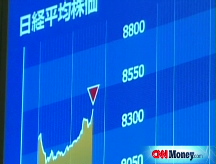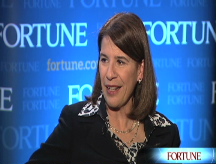Stimulus: Risk of waiting for Obama
There's a good chance the lame-duck Congress will punt the big decisions about economic stimulus to next year.
NEW YORK (CNNMoney.com) -- Mass layoffs. A dismal outlook for retailers. The prospect of state budget cuts. An economy in contraction, and forecasts that the decline will accelerate.
If lawmakers are going to pass measures to boost the economy, time is of the essence. Congress is meeting this week in a lame-duck session, but it is not precluded from coming back before the end of the year.
Despite lawmakers from both sides of the aisle agreeing that something must be done, Congress may not pass a substantial stimulus package for another two months at the earliest given all the disputes over what kind of stimulus is best, how much is needed and how to pay for it. Also consuming their time: debate over whether to offer rescue money to the Big Three automakers.
"The lame-duck session of Congress will earn its 'lame' label and pass only a grab-bag of modest stimulus, leaving the heavy lifting until early 2009," said Greg Valliere, chief political strategist for the Stanford Group, a policy research firm based in Washington, D.C.
And the delay could mute the impact of any package - or parts of it - and affect how states are likely to fare as a result.
Democrats are pushing government spending to boost state aid and food stamps, extend unemployment benefits and fund infrastructure projects. A leading Republican proposal pushes for greater tax relief for businesses and individuals and energy reform measures.
At a Wall Street Journal conference on Monday, Lawrence Summers - who is considered to be a leading candidate for Treasury Secretary in the Obama administration - said he believes stimulus measures will need to be "speedy, substantial and sustained over a several-year interval." He said estimates for how much stimulus is needed in aggregate went as high as the $500 billion to $700 billion range.
Another economist - fiscal conservative Martin Feldstein, who served as President Reagan's chief economic adviser, didn't put a price tag on how much stimulus would be needed but said a big effort was needed.
"The nation needs a program of government spending for at least the next two years to offset the large decline in consumer spending and business investment," Feldstein said at a congressional hearing Tuesday. "To be successful, it must be big, quick and targeted at increasing production and employment."
While it's very possible lawmakers might push through an extension of unemployment benefits before the year is out, it's likely that this Congress will punt the big stimulus decisions to the next Congress, which would aim to have a package ready for President-elect Barack Obama's signature when he's sworn into office on Jan. 20.
A delay in enacting stimulus could force painful decisions by states and businesses that they otherwise would not have to make, and that, in turn, could exacerbate the recession, some economists say.
Consider, for example, fiscal aid to states so they won't have to raise taxes or cut services. On the one hand, states' economic recoveries typically lag national comebacks by a year or two, and most of their fiscal years don't start until July.
The lag suggests that lawmakers have time to get money to states and still have it be useful.
But in reality, "spending decisions have to be made now. ... The longer we wait [for commitments of federal aid] the more cuts will occur," said David Quam, director of federal relations for the National Governors Association.
That's because governors typically put together their budget proposals for the next fiscal year in December and their legislatures take them up starting in January.
Since 49 states have balanced budget requirements - meaning if their revenues fall, they must compensate by making cuts or raising taxes and fees - state lawmakers may slate cuts or tax increases that otherwise might not be needed because they won't have confirmation that federal aid is on the way, Quam explained.
Lakshman Achuthan, managing director of the Economic Cycle Research Institute, also urges the federal government to act immediately to offer fiscal aid to states and local governments.
"Now is not the time for either to falter as it will only make the quickly intensifying recession much worse," Achuthan said.
As for other stimulus measures Congress may pass, they should be ready to go as soon as several bellwether economic measures begin to turn upward, Achuthan said. "That would greatly increase the chance ... [for] the type of recovery that produces jobs."
A job-based recovery, in turn, can help combat the housing crisis.
"Without a better job market, foreclosures will continue to mount," he explained.
Currently, the annualized growth rate on the research institute's Weekly Leading Index is the lowest it has been since 1949. Achuthan has said he doesn't see an economic recovery on the horizon yet.
Rich Yamarone, director of economic research at Argus Research, takes a more optimistic view about a possible delay in stimulus.
"Ideally you get it all done now," Yamarone said. "But it's not an overwhelming negative [if you don't]. This quarter is already written off. You can't save it now."
Yamarone was one of 51 economists surveyed recently by the Federal Reserve Bank of Philadelphia. The economy contracted in the third quarter and the majority of economists surveyed said they expect the same for the next two quarters. Thirty-five of the 51 economists made their predictions assuming a roughly $200 billion stimulus package would be in place.
To make sure they can put to maximum use whatever federal aid they're slated to get, states and private sector recipients should have the money in hand or access to tax relief by mid-February, according to Yamarone.
With infrastructure projects, it typically takes between three and four months for states and localities to put the money to use in "ready-to-go" projects, meaning they can get started as soon as funding is provided.
He believes if money is disbursed by mid-February, jobs will start to be created by spring. "Then it starts to snowball and build on itself," said Yamarone, who doesn't buy the argument that the economy will be in the tank for as long as some of the most gloom-and-doom forecasters.
"I think there's gloom, but I don't think there's doom. I discount the doom," Yamarone said. ![]()



